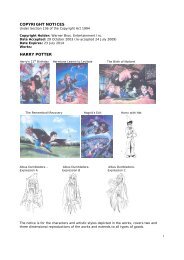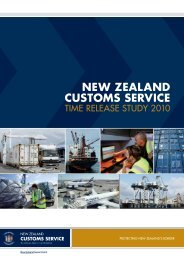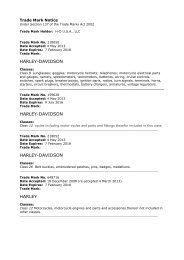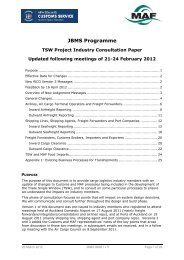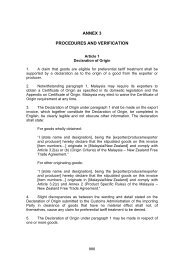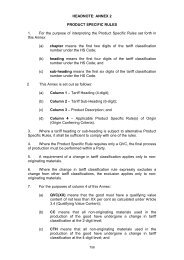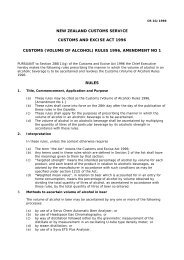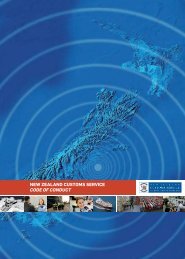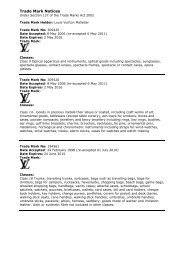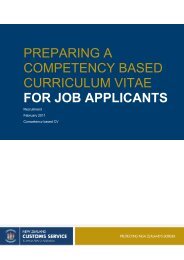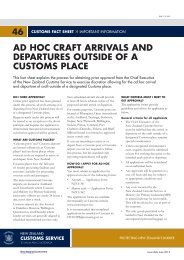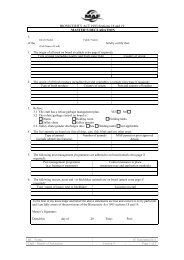TASMAN UNION - Contraband - NZ Customs
TASMAN UNION - Contraband - NZ Customs
TASMAN UNION - Contraband - NZ Customs
Create successful ePaper yourself
Turn your PDF publications into a flip-book with our unique Google optimized e-Paper software.
contrabandNEW ZEALAND CUSTOMS SERVICEJULY 2011 ISSUE 118EXERCISE<strong>TASMAN</strong> <strong>UNION</strong>
JULY 2011PUBLISHERNew Zealand <strong>Customs</strong> Service,The Customhouse,1 Hinemoa St, Wellington 6011,PO Box 2218, Wellington 6140Ph: 04 901 4500, Fax: 04 901 4555ISSN 0113-3292EDITORAaron HailwoodCONTRIBUTORSLauren Wethey, Sara Stavropoulos, Nicky Elliott,Rowan McArthur, Lisa Marriner, Angus Senior.DISCLAIMERWhile every effort has been made to ensurethat the information in <strong>Contraband</strong> is correct,readers must refer to the relevant statutorypublications for confirmation. Opinionsexpressed in this magazine are those ofthe contributors and are not necessarilythe official views of the New Zealand<strong>Customs</strong> Service.COPYRIGHTAll material published in <strong>Contraband</strong> iscopyright and may only be reproduced withthe permission of the Editor.ENQUIRIESEmail: publications@customs.govt.nzSUBSCRIBETo request your free electronic copy of thismagazine, email: publications@customs.govt.nzand list your name, organisation, and emailaddress.IMAGESNames of individual artists are available onrequest by contacting the Editor.New Zealand <strong>Customs</strong> Service is the governmentorganisation that protects the community frompotential risks arising from international trade andtravel, while facilitating the legitimate movementof people and goods across the border.As New Zealand’s gatekeepers, our role includes:intercepting contraband (such as illegal drugs);checking travellers and their baggage, cargo andmail; protecting businesses against illegal trade;and assessing and collecting <strong>Customs</strong> duties,excise taxes, and goods and services tax onimports. We use intelligence and risk assessmentto target physical checks of containers, vessels,and travellers. As a law enforcement agency weconduct investigations and audits and prosecuteoffenders.<strong>Customs</strong> works closely with the other borderagencies, the Ministry of Agriculture and Forestryand the Department of Labour ImmigrationServices.PAGE 6CUSTOMS CONTINUES SUCCESSFULRUN OF DRUG SEIZURESDrugs are a continuing focus for New Zealand <strong>Customs</strong>, andMay saw a range of seizures, including a rarely seen class Acontrolled drug.PAGE 9TRANS-<strong>TASMAN</strong> EXERCISESTRENGTHENS OUR BORDERSIn May, New Zealand <strong>Customs</strong> successfully completed ExerciseTasman Union, a joint training operation by customs serviceagencies in New Zealand and Australia.PAGE 12JOINT BORDER MANAGEMENT SYSTEMA joint border management system (JBMS) designed tosignificantly improve border processing for New Zealand tradersand travellers will be the result of a contract signed today byNew Zealand <strong>Customs</strong> and information technology provider, IBM.4 Message from The Comptroller5 Message from The Minister6 <strong>Customs</strong> continues successful run of drug seizures8 ALAC levy and Excise duty changes10 Trans-Tasman exercise strengthens our borders12 Joint Border Management System14 Q&A: John Wech15 Appointment: Dave Haigh16 Five furry graduates16 SmartGate update17 <strong>Customs</strong>’ new website18 <strong>Customs</strong>’ strategic intentions 2011-201420 Fonterra joins world’s leading customs advisory group21 Man sentenced after smuggling child objectionable material22 <strong>Customs</strong> in court2 <strong>Contraband</strong> July 2011
On 22 February 2011, Christchurch and the surrounding area were struck by anearthquake that caused severe damage and tragic casualties.The New Zealand Government has launched an appeal to help the people ofChristchurch and the Canterbury region during this time of great need. You canhelp make a difference by donating to the Christchurch Earthquake Appeal.Ways to donateOnlineCredit card donations can be made instantly at:www.christchurchearthquakeappeal.govt.nzInternet BankingDonations can be made with internet banking:Account name: Christchurch Earthquake AppealAccount number: 03 0251 0039807 00At any bank branchDonations can be made at any New Zealand bank branch.TXT donationsIf you are in New Zealand, free txt ‘chch’ to 933 to donate $3 to theChristchurch Earthquake Appeal. This option is only available in New Zealand.You will not be charged the cost of sending the text.By international telegraphic transferWestpac will waive the international service fee usually charged for anydonations made overseas by telegraphic transfer. These fees will be waivedboth for donations made in New Zealand currency or foreign currency. If you’remaking a donation from overseas, you may still be charged by your local bank.Please ask your bank to send payment by telegraphic transfer to:Westpac Banking Corporation, Wellington, New ZealandSWIFT Code: WPAC<strong>NZ</strong>2WFor credit to account: 03 0251 0039807 00Benefi ciary: Christchurch Earthquake AppealIf you wish to receive a donation receipt for donations of more than $5,please request one from the Department of Internal Affairs.Protecting New Zealand’s Border 3
MESSAGE FROMTHE COMPTROLLERProductivity. It is a word that is being used a lot at the moment within the publicservice — especially given the financial state of the Government and the increasingpressure on the public service to do more with less.It is also a word that means a lot tous here at the New Zealand <strong>Customs</strong>Service.<strong>Customs</strong> will be looking at ways thatwe can increase our productivity andprovide better value for money inour services. Over the past few years,<strong>Customs</strong>’ technological capabilityhas increased and we expect this tocontinue. We will therefore need a mixof capabilities, both in our people andour technology.Like much of the public service,we are conducting internal reviewsto make sure that our resources arewhere they are most needed, and toensure that we’re interacting with ourcustomers in the best possible way.In this year’s Budget, more fundingwas allocated for SmartGate — ourautomated passenger processingsystem. This investment will see greatproductivity gains as more low-riskpassengers are processed throughfaster, without the need for a <strong>Customs</strong>officer to assess them. This meansthat our most valuable resource, ourpeople, can be used in a more efficientmanner and focus on more high-riskpassengers.The economy is expected to recover,and while that is good news, it willmean increased volumes in bothtravel and trade. However, with theseincreased volumes will come anincrease in workload for <strong>Customs</strong>.We will continue to look forinnovative ways to meet thisdemand. SmartGate will help, aswill our continued investment in theJoint Border Management Systemand Trade Single Window — thecontract of which was signed on17 June — for which many of ourindustry partners will see a markedimprovement in dealing withgovernment agencies at the border.The Government expects <strong>Customs</strong>to still meet our targets and tocontinue to provide, and improve,the great service for which we havebecome known. We have an excellentreputation, and we want to keep thatreputation.Our priorities will change andbroaden as they always have. Whenwe were first established in 1840,revenue collection was our mainfocus. It is still a key focus for us,but we now do more than that.We facilitate trade and travel and wehelp ensure New Zealand’s security.We may need to change some longstanding practices and extend ourthinking beyond ‘what is’ to ‘whatcould be’. However, this is somethingthat we can achieve because we at theNew Zealand <strong>Customs</strong> Service prideourselves on our agility. So much sothat it is one of our four values.We will do more with less. But wewill continue to invest in areas wherenew capabilities will strengthen ourservices.John SeckerActing Comptroller of <strong>Customs</strong>4 <strong>Contraband</strong> July 2011
MESSAGE FROM THE MINISTERWhat a fantastic month May was for <strong>Customs</strong>! As well as continuing the fightagainst ‘P’, <strong>Customs</strong> officers intercepted two other dangerous drugs at our borders.It only takes a bit ofinternet research to discoverhow dangerous a drug DMTcould be on our society,particularly young people.One of the most significant eventswas the intercepting in Christchurchof a package bound for Blenheimcontaining 18 kilograms ofdimethyltryptamine (DMT).DMT is similar to LSD. It is apsychedelic drug. People react verydifferently to its use depending on theamount consumed and its purity. Thisposes a real risk to health.This class A drug is thankfully rarelyseen in New Zealand. Police inWestern Australia only made theirfirst arrests for possession of DMT inDecember 2008.Like ‘P’ it can be manufactured inpeople’s homes.It only takes a bit of internet researchto discover how dangerous a druglike DMT could be on our society,particularly young people.Just last October, three collegestudents were arrested in the UnitedStates after campus police discoveredthey had converted a GeorgetownUniversity dorm into a laboratory andwere manufacturing the hallucinogen.Another significant drug raid successhappened on 17 May, when <strong>Customs</strong>officers in Wellington arrested a34-year-old New Zealand man afterthey became suspicious of twopackages arriving from the UnitedStates. The packages contained1.2 litres of the class B controlleddrug gamma-butyrolactone (GBL),smuggled in nail polish bottles.It is also known as a ‘date rape’drug because it can render a victimunconscious and produce memoryloss. An overdose can cause nausea,vomiting, convulsions, coma, anddeath.Sadly abuse of GBL is alreadyhappening in New Zealand andis particularly popular in both thenightclub and party scene as itproduces feelings of sedation andeuphoria.At least this particular stock is off ourstreets and away from doing anyoneany harm.The DMT and GBL seizures followon from a very successful Aprilwhen <strong>Customs</strong> officers arrested tenMalaysian drug couriers carrying‘P’ in their shoes on their arrival atAuckland Airport.I have also had the pleasure ofmeeting with the <strong>Customs</strong> traineesin Wellington on 16 June and thenattending their graduation ceremonyin Auckland on 25 June.I know these new graduates are goingto a department that strives on successand results — as the months of Apriland May have shown. I wish them allthe best in their future careers.Hon Maurice Williamson,Minister of <strong>Customs</strong>Protecting New Zealand’s Border 5
CUSTOMS CONTINUESSUCCESSFUL RUN OFDRUG SEIZURESDrugs are a continuing focus for the New Zealand <strong>Customs</strong> Service,and May saw a range of seizures, including a rarely seen class Acontrolled drug.NEW DRUG AN EMERGINGTHREATIn Blenheim, Christchurch-basedofficers made an arrest after mailbound for Blenheim containing ararely seen class A controlled drugdimethyltryptamine (DMT) — similarto LSD — was detected at the mailcentre in Auckland.The package contained 18 kilogramsof DMT. Previously very smallinterceptions have been noted inNew Zealand, however this is certainlythe largest on record. DMT is apsychedelic drug where people reactvery differently to its use dependingon the amount consumed and itspurity. This poses a real risk to health.A joint operation between <strong>Customs</strong>and the New Zealand Police led to asearch of the property the packagewas addressed to. <strong>Customs</strong> officersarrested a 21-year-old male at theproperty, who has been charged withimportation of a class A controlleddrug.The maximum penalty for such anoffence is life imprisonment.DATE RAPE DRUG SMUGGLED INNAIL POLISH BOTTLESOn 17 May 2011, New Zealand<strong>Customs</strong> officers in Wellingtonarrested a 34-year-old New Zealandmale after they became suspiciousof two packages arriving from theUnited States. The packages contained1.2 litres of the class B controlleddrug gamma-butyrolactone (GBL),smuggled in nail polish bottles.The abuse of GBL is widespreadthroughout New Zealand and isparticularly popular in both the nightclub and party scene as it producesfeelings of sedation and euphoria.It is also known as a ‘date rape’drug because it can render a victimunconscious and produce memoryloss. An overdose can cause nausea,vomiting, convulsions, coma, anddeath.The man has been charged with twocharges of importation of a classB controlled drug, which carriesa maximum penalty of 14 years’imprisonment.At the end of the first quarter of this calendar year,New Zealand <strong>Customs</strong> has made 220 interceptions ofpseudoephedrine or ephedrine … removing in the vicinityof $27 million of potential harm from New Zealand.THE FIGHT AGAINST ‘P’CONTINUESOn 16 May 2011, in a joint <strong>Customs</strong>and Police operation, a 39-year-oldmale was arrested in Whangareiafter <strong>Customs</strong> officers intercepted apackage from the United Kingdomin Auckland. It contained individuallysealed and wrapped packets of theclass C drug ephedrine — a substancecommonly used to manufacturemethamphetamine (‘P’) — with atotal weight of 4 kilograms.A few days earlier, <strong>Customs</strong> officershad intercepted another package fromThailand destined for another addressin Whangarei containing packets ofwhite powder that were also found tocontain 3 kilograms of ephedrine.Both packages had been declared asherbal powder scrub and totalled8 kilograms. This amount of precursorcould produce between 3.5 and4.9 kilograms of ‘P’. The communityharm caused by this amount of ‘P’comes to between $1.41 millionand $1.97 million dollars.The male has been charged withimportation and possession forsupply of a class C controlled drugwhich carries a maximum penalty ofeight years’ imprisonment.6 <strong>Contraband</strong> July 2011
MORE DRUGS IN SHOESIn a repeat of the recent drugsin-shoesincident, officers inChristchurch caught a man returningfrom Thailand with pseudoephedrinein his shoes and bag. His companionwas carrying more in her luggage.The total weight of pseudoephedrinewas 217 grams.Both were charged with importationof a class C controlled drug whichcarries a maximum penalty of eightyears.This intercept follows the Aprilincident at Auckland Airport when agroup of ten Malaysian drug couriers,all in the same tour group and allcarrying crystal methamphetamine(‘P’) in their shoes, were caught by<strong>Customs</strong> officers.At the end of the first quarter of thiscalendar year, New Zealand <strong>Customs</strong>has made 220 interceptions ofpseudoephedrine or ephedrine witha potential yield of between 48 and67 kilograms of methamphetamine(‘P’) removing in the vicinity of$27 million of potential harm fromNew Zealand.Protecting New Zealand’s Border 7
ALAC LEVY ANDEXCISE DUTYCHANGESNew rates for both the Alcohol Advisory Councilof New Zealand levy (ALAC levy) and excise andexcise-equivalent duty rates on alcohol productsapplied from 1 July 2011.ALAC LEVYNew rates for the Alcohol Advisory Council ofNew Zealand levy (‘ALAC levy’) came into effect from1 July 2011. The new rates are those set out in the AlcoholAdvisory Council Levy Order 2011.The rates are payable on per litre of beverage and canbe found on our website www.customs.govt.nz.The new rates are payable on all alcoholic beveragesimported or removed from <strong>Customs</strong> controlled areason and after from 1 July 2011.EXCISE DUTY RATESThe annual adjustment to the excise and excise-equivalentduty rates on alcohol products also took place on1 July 2011.The annual adjustment is based on movements in the‘Consumers Price Index All Groups excluding creditservices’ over the 12-month period to 31 March 2011.The new rates are those set out in the Excise and ExciseequivalentDuties Table (Alcoholic Beverages Indexation)Amendment Order 2011 and can be found on our websitewww.customs.govt.nz.Alcohol products removed from a licensed manufacturingarea or imported on or after 1 July 2011 will be subject tothe new rates.IF YOU NEED FURTHER INFORMATION,PLEASE CONTACT CUSTOMS ON0800 428 786 (0800 4 CUSTOMS).8 <strong>Contraband</strong> July 2011
EXERCISE <strong>TASMAN</strong> <strong>UNION</strong>TRANS-<strong>TASMAN</strong> EXERCISESTRENGTHENS OUR BORDERSIn May, the New Zealand <strong>Customs</strong>Service successfully completedExercise Tasman Union, a jointtraining operation by customsservice agencies in New Zealandand Australia.The two-week exercise was basedon a scenario involving connectedprecursor drug importations intoNew Zealand and Australia by anorganised crime syndicate using smallcraft. In the exercise, both countrieswere required to respond to the threatat their respective borders.Minster of <strong>Customs</strong>, Hon MauriceWilliamson, congratulated Australianand New Zealand <strong>Customs</strong> officerson a successful operation and theircontinued good work to protect ourcountries from illegal activities.“Maintaining effective borderprotection,” said Mr Williamson,“shows our dedication to stopping thecriminals that try to bring illicit goodsinto our two countries.”Exercise Tasman Union wasconducted as a way for both <strong>Customs</strong>agencies to test their ability to respondduring joint operational activities.A key objective of the exercise was toassess how to further improve jointoperational activity in the future.Australian Minister for Home Affairs,Brendan O’Connor, said internationalcooperation is vital to effectivelymanage threats to our borders.“Organised criminals don’t respectnational borders and will try to exploitany opportunity they can. That’s whyProtecting New Zealand’s Border 9
EXERCISE <strong>TASMAN</strong> <strong>UNION</strong>we need to maintain good practiceswith our neighbours and stay one stepahead of organised crime networks,”Mr O’Connor said.Mr Williamson said that the exercise isanother example of the great workingrelationship between the New Zealand<strong>Customs</strong> Service and the Australian<strong>Customs</strong> and Border ProtectionService.“Working together to keep up-todatein maintaining effective borderprotection is a further step forwardin our trans-Tasman relationship andshows our dedication to stopping thecriminals that try to bring illicit goodsinto our countries,” Mr Williamson said.Assistance from the New ZealandDefence Force in particular the RoyalNew Zealand Navy contributed to theexercise’s success.The two-week exercisewas based on a scenarioinvolving connectedprecursor drug importationsinto New Zealand andAustralia by an organisedcrime syndicate using smallcraft. In the exercise, bothcountries were requiredto respond to the threat attheir respective borders.10 <strong>Contraband</strong> July 2011
Protecting New Zealand’s Border 11
JOINT BORDERMANAGEMENT SYSTEMCONTRACT SIGNEDA joint border management system (JBMS) designed to significantly improve borderprocessing for New Zealand traders and travellers, and to make border agenciesmore efficient, will be the result of a contract signed in June by New Zealand<strong>Customs</strong> and information technology provider, IBM.The JBMS brings together the twoborder processing systems previouslyrun independently by <strong>Customs</strong> andthe Ministry of Agriculture andForestry (MAF) — CusMod andQuantum respectively.This year’s Budget announcementincluded a $75 million appropriationto cover the first stage of the system’sdevelopment. Stage one will includewhat is called the Trade SingleWindow (TSW). Ultimately, TSWwill enable exporters, importers,and others involved in trade tocomplete all their border compliancerequirements, online through a singlepoint of electronic contact.<strong>Customs</strong> Acting Comptroller, JohnSecker said JBMS was a majorstrategic asset for New Zealand.“As well as meeting trade and industryrequirements, it also serves our needsacross border security, biosecurity,intelligence related to smuggling, andfacilitating legitimate travel,” he said.“We are very pleased to be joinedclosely with MAF on this, and JBMSwill ensure we can have more effectiveand efficient linkages with othergovernment agencies and with industry,to the benefit of New Zealand’seconomy and its security.”Mr Secker said it was a large andcomplex project that would bevery carefully managed. “We havealready begun an ongoing processof consultation with industry andother government agencies to ensurethat the system is as effective andbeneficial as it can possibly. It’s a hugeopportunity for all of us.”It is anticipated that the JBMS will bebuilt and implemented in two stagesover a four-year period.MAF’s Director-General WayneMcNee says the internationalborder management environmentis constantly evolving and agenciesinvolved in border activities need tomove with it.The JBMS will move agencies away from fragmentedseparate processes that result in duplication of effort, to afar more cohesive system that shares processes, data, andtechnology between border agencies and industry.“JBMS is part of that evolution andMAF is pleased to be working with<strong>Customs</strong> and IBM to ensure the needsof industry and government are met.”Kerrie McGrath, Managing Partner,IBM Global Business ServicesNew Zealand, said IBM was verypleased to become the prime systemsintegrator to develop New Zealand’sJoint Border Management System.“We bring to this project our specialistexpertise in risk and intelligenceanalytics, and our proven experiencein customs and border management.This is combined with the consultingand delivery capabilities of our localteam, and our partner Datacom.”WHAT IS JBMS?The JBMS brings together the twoborder processing systems previouslyrun independently by <strong>Customs</strong> andMAF — CusMod and Quantumrespectively. JBMS will be a collectionof shared services, mostly hosted by<strong>Customs</strong>, to support the clearance ofpeople, goods, and craft across theNew Zealand border.12 <strong>Contraband</strong> July 2011
The JBMS brings together the two border processingsystems previously run independently by <strong>Customs</strong> and theMinistry of Agriculture and Forestry (MAF) – CusMod andQuantum respectively.The JBMS includes the ‘TradeSingle Window’ — a facility that willultimately enable importers, exporters,and other supply chain participantsto electronically submit compliancerelatedinformation required for theclearance of goods and craft once,rather than to multiple agencies.JBMS will provide <strong>Customs</strong> and MAFwith modern technology to:» receive and process enhancedelectronic cargo and passengerinformation» simplify and better manage borderclearance processes for trade andtravel» target high-risk and facilitate lowriskpeople, goods, and craft» enhance linkages to othergovernment agency systems» improve coordination of resourcesacross agencies» contribute to improved logisticsmanagement in the supply chain.WHY IS IT NECESSARY?The CusMod (<strong>Customs</strong>) andQuantum (MAF) operationalcomputer systems are over 12 yearsold and both agencies were due toreplace them to maintain services andthe ability to respond to a constantlyevolving international bordermanagement environment.The JBMS will move agencies awayfrom fragmented separate processesthat result in duplication of effort,to a far more cohesive system thatshares processes, data, and technologybetween border agencies and industry.WHAT ARE THE BENEFITS?Agencies are required to worksmarter and get better results withless funding. Investing in JBMS willsupport us to provide more efficientservices to the trade and logisticsindustry, and improve our ability toprotect New Zealand through betterrisk identification, threat prediction,and trend monitoring.At the core of the system is a riskmanagement framework that willuse sophisticated risk assessmentand pattern analysis technologiesto provide <strong>Customs</strong> and MAF withsmarter targeting of people, goods,and craft crossing the border. Thiswill result in faster clearance for thosewho comply and more attention beingpaid to those who do not.The JBMS will help <strong>Customs</strong> andMAF to give trading partners provenassurance about the safety andcompliance of New Zealand’s exports.It will help speed up the clearanceof low-risk international travellers,thereby enhancing the passengerexperience.WHAT ARE THE IMPACTS?Implementation of the JBMS willinvolve changes to the data requiredfor the clearance of craft and cargo,and to border processes. <strong>Customs</strong>and MAF are consulting with industryon proposed changes via a rangeof forums, including a Trade SingleWindow Industry Reference Group.Implementation of the JBMS willrequire an increase in fees recoveredfrom importers and exporters forcargo clearance services. <strong>Customs</strong>and MAF have previously consultedindustry on the likely costs andpotential recovery options, and willconsult further as the costs and newclearance processes are confirmed.HOW WAS IBM SELECTED?<strong>Customs</strong> and MAF received fiveresponses to a Request for Proposalissued to the ICT industry in 2010.The evaluation process includedconducting over 50 discovery anddue diligence meetings with the shortlisted vendors; and the completionof 15 reference checks with agenciesin Australia, Canada, New Zealand,the United Kingdom, and the UnitedStates.Audit New Zealand acted asindependent quality assurer for theselection process.Protecting New Zealand’s Border 13
Q&AJOHN WECHJohn Wech is the <strong>Customs</strong> Counsellor based at the New Zealand High Commission in Canberra, Australia, and hasheld this since February this year. <strong>Contraband</strong> caught up with him to discuss life in Australia’s buttoned-down capital.What was your firstQ: impression of Canberra?Space. As a planned city andA: the federal capital, Canberrahas lots of open public spaces alongwith cultural and social institutionsyou normally wouldn’t find in acity this size — the population isapproximately 350,000.Is there anything thatQ: frustrates you aboutliving/working in Canberra?The price of bananas. At overA: A$14 a kilogram, what wasonce a staple of our diet inNew Zealand is now a luxury!What is the purpose ofQ: your role in Canberra?I am the key contact andA: liaison point for New Zealand<strong>Customs</strong>’ relationship with Australianagencies. I support developmentand implementation of initiativesthat progress the New ZealandGovernment’s interests internationallywith a focus on the relationship withAustralia — New Zealand’s mostimportant bilateral relationship.What happens in aQ: typical day at work foryou?Every day differs with a lotA: of variety in this role, butgenerally mornings are filled withworking through enquiries andupdates from New Zealand andfollowing up on these as requiredwith the appropriate people inNew Zealand or Australian agencies.I have frequent meetings withAustralian agencies, the regularface-to-face contact being the biggestadvantage of being located offshore,and that pays dividends whenassistance is required. From about3pm contact from New Zealand dropsoff as those on office hours inNew Zealand head home, and thatallows me to do some forwardplanning and catch up on reportwriting and administration.Are you working on anyQ: big projects/initiatives atthe moment?There are some importantA: projects underway across thespectrum of <strong>Customs</strong>’ interests inAustralia, all at different stages, andall important in different ways. Thetrans-Tasman travel facilitation work isprobably the highest profile and mostadvanced, but there are also someopportunities in the trade, targeting,and intelligence domains that shoulddeliver greater efficiency and/orcapability for all the parties involved.Do you have any alliesQ: or buddies who youwork closely with or who havethe same interests?Certainly in the area of lawA: enforcement, I would class allthe enforcement agencies in Australiaand the community of foreign lawenforcement liaison officers inCanberra as allies or buddies. We allhave a common interest in upholdingthe law and disrupting organisedcrime wherever it may be operating.One country’s problem today can beanother’s tomorrow.There are also the ‘New Zealand Inc’allies or buddies made up of thoseNew Zealand agencies representedin Australia. Each of these agenciesbrings unique knowledge andrelationships to the table and will goout of their way to assist.14 <strong>Contraband</strong> July 2011
APPOINTMENT OFNEW CUSTOMSCOUNSELLORIN BANGKOKHave you seen much ofQ: the <strong>Customs</strong> operationsin the region?I spend a lot of time with theA: areas in Australian <strong>Customs</strong>and Border Protection Service whoare responsible for internationalinformation exchange and operationalcoordination. These areas are alllocated in Canberra and so, to dateanyway, I’ve not travelled widely.What is the generalQ: opinion of New Zealand<strong>Customs</strong>?The strength of theA: relationship betweenNew Zealand and Australia hasbeen demonstrated all too clearlyrecently with the support providedby Australia to New Zealandfollowing the devastating earthquakein Christchurch in February — myfirst week in the job here. Thestrength of the relationship hasalso been summarised well in therespective Prime Ministers’ addressesto the other country’s Parliaments.The relationship betweenNew Zealand <strong>Customs</strong> andAustralian <strong>Customs</strong> mirrors thisrelationship with a great deal ofgoodwill readily demonstratedwherever assistance may be required.The work of my predecessors(New Zealand <strong>Customs</strong> havemaintained a post in Australia for42 years) in the post to build andmaintain that goodwill is oftenevident in my dealings with Australiancustoms officers, and something I’malways mindful of maintaining andbuilding on for my successor.Like any relationship, it is importantthat it is not taken for granted,remains forward looking whileacknowledging the history of closecooperation, and delivers benefits forboth parties.What do you missQ: about your job inNew Zealand?It’s a cliché, but the people.A: That said, as the closest postto New Zealand and due to the extentof our engagement with Australianagencies, I get frequent visitors andthe opportunity to catch up on newsfrom home.There are also some very excitingwork programmes underway inNew Zealand <strong>Customs</strong> at the momentthat will define <strong>Customs</strong>’ role andcapabilities for the next decade ormore.DAVE HAIGHCUSTOMS COUNSELLORDave Haigh started his roleas <strong>Customs</strong> Counsellor basedin Bangkok, Thailand, on 16May 2011.Dave was previously <strong>Customs</strong>’Manager Multi-lateral andRegional Cooperation. Hereplaces Mark O’Toole inBangkok.We congratulate John onachieving this significantmilestone in his <strong>Customs</strong>career and wish him asuccessful posting to Bangkok.Protecting New Zealand’s Border 15
FIVE FURRY GRADUATESThree <strong>Customs</strong> drug detector dogteams and two <strong>Customs</strong> explosivedetector dog teams graduated atthe Police Dog Training Centre inTrentham on 28 April 2011.The graduation was attendedby the Minister of Police andCorrections Judith Collins, DeputyPolice Commissioner Viv Rickard,and <strong>Customs</strong> Group ManagerInvestigations and Response, Bill Perry.From left: Senior <strong>Customs</strong> Officer (SCO) Debbie and Jerry (drugs), <strong>Customs</strong> Officer (CO)Chad and India (drugs), SCO Pettina Mitchener and Zen (drugs), CO Keith and Urik(explosives), and SCO Blair and Isla (explosives).All the handlers were trained withdogs supplied by the Australian<strong>Customs</strong> and Border ProtectionService Detector Dog Breedingand Development Programme inMelbourne.SMARTGATE UPDATESmartGate, the automated passport processing system continues to gofrom strength to strength. More than 1,000,000 passengers have beenprocessed through SmartGate and it has been embraced by the public,so much so that new SmartGate hardware will go into our three keyinternational airports by early August.In Auckland, there will be two newdeparture gates, one arrival gateand another six kiosks for a total offour departure gates, seven arrivals,and 18 arrivals kiosks altogether.Wellington will get its third arrivalgate, and Christchurch will have twomore arrival gates and another sixkiosks, for a total of four gates and 12kiosks in total on arrival. Christchurchwill also have two departure gatesinstalled.Additional SmartGate capacity willgreatly assist in the managementof major events such as the RugbyWorld Cup 2011 which will seeincreased passenger numbers into ourinternational airports.Budget 2011 included an extra $3.5million in operational funding forSmartGate and $3.4 million in capitalspending for 2011/12.Demand is being driven by theincrease in New Zealand andAustralian passengers with ePassportswho are eligible to use it. Tourismvolumes are also expected to increaseover the next few years.In late July, we are also launching atrial to integrate with the Australian<strong>Customs</strong> and Border ProtectionService’s SmartGates which will seepeople able to use the SmartGatedepartures kiosk in New Zealandto complete the first step of theSmartGate arrival process for travelto Gold Coast Airport. On arrival atGold Coast Airport, passengers whohave completed the kiosk questionson departure in New Zealand, will beable to go straight to the gate.16 <strong>Contraband</strong> July 2011
CUSTOMS’ NEW WEBSITENext time you need information ona <strong>Customs</strong>-related issue, make sureyou check out the new website forthe New Zealand <strong>Customs</strong> Service.The new website was launched onMonday, 16 May and is much easierto use.“After consultation with a number ofuser groups and extensive planningwe have developed a site that ismore intuitive with easier navigation,improved functionality, a new searchengine, and a better platform toallow us to provide added features inthe future,” says Rowan McArthur,<strong>Customs</strong>’ Communications Manager.The site has been developed with anew look and feel that better reflects<strong>Customs</strong> identity and role.“While we have put the new sitethrough a thorough testing process,there are bound to be some early‘teething’ issues,” adds Rowan.“So if you discover something thatappears to be incorrect, or anyother helpful suggestions, we wouldwelcome your feedback.”Feedback can be sent via email onfeedback@customs.govt.nz.Also, if your organisation links to orcaptures content from our websiteyou may need to update the links thatyou currently have in place.We hope you enjoy the new site!Protecting New Zealand’s Border 17
CUSTOMS’ STRATEGICB.24 SOI (2011)The New Zealand <strong>Customs</strong> Service Statement of Intent 2011–2014 (SOI)was published on Budget day. The SOI contains <strong>Customs</strong>’ strategicintentions to support the Government’s goals for New Zealand.NEW ZEALANDCUSTOMS SERVICESTATEMENT OF INTENT 2011–2014These are:» to build the foundations for astronger economy, based onenduring growth» better results from the publicservices New Zealanders rely on,while delivering value for money.» Trade — Streamline and simplifytrade facilitation, and promote secureand efficient trade, particularly withAustralia and China.» Travel — More efficient,streamlined, and secure passengerfacilitation, particularly for trans-Tasman and Asia-Pacific travel.The focus is ondelivering better,more streamlinedservices, moreefficiently.4/28/11 12:07:51 PMThe focus is on delivering better,more streamlined services, moreefficiently.<strong>Customs</strong> protects New Zealand’sborder, while facilitating trade andtravel, and collecting Crown revenue.To support the Government’sgoals, the aim is to make it easierfor traders to do business at theborder by reducing their complianceburden; improve the passage of tradethrough customs in New Zealand andoverseas; and provide a more seamlessexperience that reduces delays forlegitimate travellers, while maintaininghigh levels of protection. Deliveringon the Government’s significantinvestments and streamlining servicesare critical to these aims; and otherefforts to increase productivityand efficiencies for industry andgovernment.From 2011, the Minister of <strong>Customs</strong>,Hon Maurice Williamson, has agreedthree priorities for <strong>Customs</strong>:» Protection — Increase disruptionof supply and dismantle criminalnetworks, particularly for illicit drugsand people smuggling, and maintainresponsiveness as risks change.The Trade priority supports theGovernment’s focus on New Zealandexports as critical to strengtheningNew Zealand’s economy. The Travelpriority reflects the need to manageincreasing volumes of travel. Bothpriorities recognise the Government’saim to progress the trans-Tasmansingle economic market agenda; andthe prospect of increasing trade andtravel from China and other Asia-Pacific countries.The focus on implementing the JointBorder Management System–TradeSingle Window (JBMS–TSW) by 2014,subject to approval of the stage twoJBMS business case will be criticalto these aims. Once completed,the JBMS will make it possible tointegrate customs information withthe systems for New Zealand’s18 <strong>Contraband</strong> July 2011
INTENTIONS 2011-2014trade partners; and improve our riskassessment to enhance trade securityand protection for travellers. TheTSW will provide a single electronicportal linking New Zealand traderswith border agencies, making iteasier for them to complete borderrequirements.The priority also includes continuingto progress New Zealand’s free tradeagreements; and mutual recognitionand other arrangements with overseascustoms administrations. Theseare important to improving marketaccess and the flow of New Zealandtrade through customs overseas; andstemming the flow of harmful goodsto New Zealand. We will continue topromote secure and efficient trade inother ways, which includes developinga Trade and Excise ManagementStrategy with the Ministry ofAgriculture and Forestry that willconsolidate and focus our effortsfor trade.The Travel priority reflects theGovernment’s additional investmentof $3.5 million in the recent Budget.It involves expanding the SmartGateprogramme to six more gates and 13self-service kiosks across Auckland,Wellington, and Christchurchinternational airports. It also includesa trial involving the integration of theSmartGate system across the Tasmanfor travellers departing Auckland andarriving at Coolangatta, Australia.The Protection priority reflectsthe Government’s ongoingcommitment to disrupt the supplyof methamphetamine or ‘P’ and itsprecursors — the chemicals usedto make ‘P’, and dismantle criminalnetworks. It also recognises the risk ofpeople smuggling, and other risks asoffending patterns change. <strong>Customs</strong>will continue targeted operations andinspections, and implement advancedtechnology to support investigations.IN SUMMARYThe focus on preparedness exerciseswill continue, including vigilance andreadiness during the Rugby WorldCup 2011.<strong>Customs</strong> collects 15 percent oftotal Crown revenue. While thefocus on revenue is not an expresspriority, revenue collection continuesto be critical to supporting theGovernment’s goals for New Zealand.» <strong>Customs</strong> aims to support the Government’s goals for a strongereconomy and focus on New Zealand exports.» From 2011, <strong>Customs</strong> will focus on three priorities: Trade, Travel,and Protection.» The Trade priority aims to make it easier for traders to do businessat the border, improve the passage of trade through customs inNew Zealand and overseas, and improve trade security.» The Travel priority involves expanding the SmartGate programmeto six more gates and 13 more self-service kiosks across Auckland,Wellington, and Christchurch; and trialling SmartGate betweenCoolangatta, Queensland and Auckland.» The Protection priority will continue efforts to increase disruptionof supply and dismantle criminal networks, particularly for illicitdrugs through targeted operations and inspections, and advancedtechnology to support investigations.» We will maintain vigilance and readiness during the Rugby WorldCup; and continue response and preparedness exercises to combatother risks, such as people smuggling.» Implementing the Joint Border Management System–Trade SingleWindow will be critical to achieving <strong>Customs</strong>’ priorities.» <strong>Customs</strong> collects 15 percent of total Crown revenue, whichcontinues to be important to support the Government to achieve itsgoals for New Zealand.Protecting New Zealand’s Border 19
FONTERRAJOINS WORLD’S LEADINGCUSTOMS ADVISORY GROUPFonterra has become the first New Zealand company to be invited tojoin the World <strong>Customs</strong> Organization’s Private Sector Consultative Group(PSCG).The PSCG provides trade-relatedadvice to the World <strong>Customs</strong>Organization, the intergovernmentalbody that develops global customsstandards, and procedures relatingto trade facilitation and supply chainsecurity.Fonterra Group <strong>Customs</strong> Manager,Robb Stevens, says membership of the30-strong PSCG is by invitation onlyand includes major global companiessuch as General Motors, IBM, FedEx,and the World Shipping Council.Mr Stevens says the invitation tojoin recognises the cooperative’sglobal presence as a manufacturer,international seller and experience with<strong>Customs</strong> authorities in various markets.As a member of the PSCG, the cooperativewill have input in simplifyingcustoms processes to smooth theflow of goods for all New Zealandimporters and exporters.“The PSCG has significant influenceon the WCO’s role in supportingthe growth of world trade. This agenuine opportunity for a majorNew Zealand company to have a sayin the development of more efficientglobal supply chains.”Since its establishment in 2006,the PSCG’s focus has beenimplementation of the WCO’s SAFEFramework of Standards to Secureand Facilitate Global Trade. TheGroup now also advises the SecretaryGeneral and WCO Policy Commissionon issues such as the impact of theglobal financial crisis and businessrecovery.“As a country that relies on exports,it’s in our interests to see consistencyin market rules, access and regulation.As the world’s largest dairy exporterand with our products now in over140 countries, we have an importantcontribution to make both forNew Zealand and for Fonterra,”says Mr Stevens.The New Zealand <strong>Customs</strong> ServiceGroup Manager Policy, Denise Hing,says having a company involved inthis group is a major opportunity forNew Zealand.20 <strong>Contraband</strong> July 2011
MAN SENTENCEDAFTER SMUGGLING CHILDOBJECTIONABLE MATERIALA man who smuggled hundredsof movie and still images showingchildren as young as two-yearsoldbeing sexually abused wassentenced in the Hamilton DistrictCourt in late May to one year and11 months’ imprisonment aftera New Zealand <strong>Customs</strong> Serviceinvestigation.The material was brought in ondiscs concealed within the coversof legitimate movie titles as well asdownloaded from overseas websites.The man, 43-year-old New Zealandresident Andrew Floyd Williams,pleaded guilty to 30 charges ofknowingly importing objectionablepublications into New Zealand. Hereceived a 25 percent reduction of hissentence for an early guilty plea.The images of children (aged between2 and 13 years old) depicted a widerange of child sexual abuse includingpictures of children, naked childrenposing, and sexual activity betweenadults and children.The worrying aspect of this activity is that it is not avictimless crime, it is increasing in volume, numbers ofoffenders, and seriousness of content.Williams was stopped at AucklandInternational Airport in 2009 afterreturning from a holiday in Thailand.<strong>Customs</strong> officers located 14 discsdepicting the sexual abuse of childrenhidden in movie covers.<strong>Customs</strong> investigators then executeda search warrant at Williams’ homeaddress in Hamilton during whichcomputer equipment was seized.Forensic analysis of the equipmentrevealed in excess of 800 images andmovie files containing child abusemessages.The majority of the images hadbeen downloaded from the internetfrom websites based outside ofNew Zealand.The investigation involved closeliaison with New Zealand Police andthe Department of Internal Affairs.<strong>Customs</strong> Acting Comptroller, JohnSecker said <strong>Customs</strong> will continue toinvestigate these types of people andtheir behaviour.“Our communities need to beeducated that the online movementand trading of child sexual abusematerial is regularly happeningthroughout all corners of our society.The worrying aspect of this activityis that it is not a victimless crime,it is increasing in volume, numbersof offenders, and seriousness ofcontent”.“Every photograph captures an actualsituation where a child has beenabused”, he said.<strong>Customs</strong>, New Zealand Police, and theDepartment of Internal Affairs workin a task force capacity to investigateinstances of the importation,exportation, possession, and tradingof online child sexual abuse materialwith the ultimate goal of identifyingand protecting children from contactoffending.Protecting New Zealand’s Border 21
COURT REPORTCUSTOMS IN COURTOBJECTIONABLE MATERIAL, DRUG IMPORTATION,FRAUD, AND UNAUTHORISED DELIVERIESSince the last edition, there has been a wide variety of charges determined in the courts. A few of thosecharges and their conclusions are set out below.OBJECTIONABLE MATERIALOn 15 April, a man appearedin the Waitakere District Courtfor sentencing. The man had beencharged with knowingly importingobjectionable material, possessionof the material and making anobjectionable publication.The judge imposed a sentence ofsix months’ community detention,18 months’ intensive supervisionand 18 months’ judicial monitoring.The judge also made an order for thedestruction of any electronic devicesretained by <strong>Customs</strong>.The judge adopted the recommendedstarting point of three years’imprisonment and reduced this to 18months for the guilty plea (at the firstcall) and other personal mitigation.DRUG IMPORTATIONA man pleaded guilty, in theManukau District Court, to onecount of importing mephedrone, aclass C controlled drug which is ananalogue of the class B controlleddrug methcathinone. The man wassentenced, on 12 May 2011, to 3months’ community detention and100 hours’ community work.Also in the Manukau DistrictCourt, another man was sentencedto two years and six months’imprisonment. The man had beencharged with importing 11,280 gramsof pseudoephedrine, which he hadconcealed inside a compressor.FRAUDA man and woman wereunsuccessful in their applicationto obtain a discharge withoutconviction under s106 of theSentencing Act.The couple had been charged withmultiple counts of failing to makeentries, knowingly making erroneousentries, committing acts for thepurpose of evading duty, and forbeing in the possession of and sellingof goods known to be uncustomed.The judge went on to impose a totalpenalty of $90,901.36 for the woman’soffending and a penalty of $9,151.36for the man’s offending. These aresignificant penalties and the judgetook a particular focus on the need todeter such offending.UNAUTHORISED DELIVERIESGuilty pleas were enteredon behalf of a company inregards to three charges of makingan unauthorised delivery. On 2 March2011, the company was convictedand fined $2,800 in respect of eachcharge and ordered to pay court costsof $132.80. The company had beenconvicted on 25 previous occasionsfor the same type of offence. Thefine on the last occasion was $2,500per charge.Another company entered guiltypleas, at the Manukau DistrictCourt, to charges also relating tounauthorised deliveries. The Crownon behalf of <strong>Customs</strong> submitted afine for each charge of $2,000 wasappropriate due to the number ofincidents, the risk the offending poses,the need to deter the company fromconsidering this type of offendingto be a business expense, and thefact the company has six similarprevious convictions. DefenceCounsel submitted $1,500 was moreappropriate however the Judgesupported the Crown’s submissionsand imposed a fine of $2,000 foreach charge.22 <strong>Contraband</strong> July 2011
SmartGateDepartures now open at Auckland and Wellington AirportsHolders of New Zealand and AustralianePassports have the option of usingSmartGate when arriving at Auckland,Christchurch, and Wellington Airports.Now you can also use SmartGate whendeparting at Auckland and WellingtonAirports. Christchurch will follow in lateJuly 2011.SmartGate offers you a simple and efficientway to self-process through passport controlwith an easy two-step process.While New Zealand <strong>Customs</strong> is pleased tooffer you this option, you can still have yourePassport manually checked if you prefer.Passports with the international ePassportsymbol* are called ePassports. If you have thissymbol on your passport you will be able to useSmartGate.*All New Zealand passports issued after November 2005 and allAustralian passports issued after October 2005 are ePassports.ePassport symbolFor more information visit www.customs.govt.nzHow to use SmartGate for departures1 STEP ONE2• Look for the SmartGate kiosk –signs will help guide you.• Place your ePassport into thereader by simply followingthe instructions on the screen.• Answer the standard declarationquestions using the touch screen.• The kiosk will issue you with aSmartGate ticket, which youwill need for Step 2.STEP TWO• Proceed to the gate and insertyour SmartGate ticket.• Look at the camera ahead ofyou while your face is comparedto your ePassport photo.• Retrieve your ticket andproceed through the gate.• Hand in your SmartGateticket and departure card, andproceed through the AviationSecurity Service screeningpoint.Protecting New Zealand’s Border 23
NGA KUPU MAORI OTE MANA ARAI O AOTEAROATHE MAORI WORDSOF THE NEW ZEALANDCUSTOMS SERVICETe Mana Arai oAotearoaMataara, kakamaTautoko, piriponoNgākau tapatahiWhakariteKohikohi tākePāhihiUtangaWaka rererangiMātakitangaIpuKai whakawhetawhetaNew Zealand<strong>Customs</strong> ServiceAgilityCommitmentIntegrityRespectCollecting dutyand taxesPassengerCargoAircraftInspectionContainerInvestigatorTe wiki o te reo Māori4–10 Hōngongoi 2011Māori language week4–10 July 2011ArotakePatu tangata haraAuditProsecute offendersManaakitanga 2011 logo courtesy of Te Taura Whiri i te reo Māori24 <strong>Contraband</strong> July 2011



